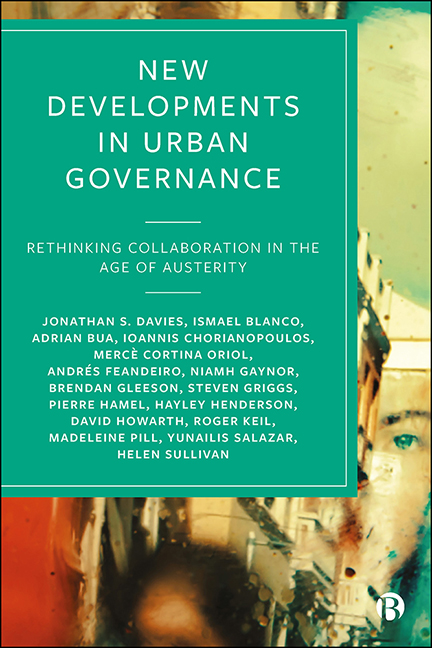Book contents
- Frontmatter
- Contents
- List of Figures and Tables
- Acknowledgements
- Introduction
- 1 Crisis and Austerity in Eight Cities: An Overview
- 2 Collaborative Governance After the Global Economic Crisis
- 3 Austerity Governance, Political Resistance and Urban Transformation
- 4 Rescaling through Austerity Governance
- 5 The Local State in Austerity Governance
- 6 Urban Cultural Diversity and Economic Migration in Austere Times
- 7 Conclusion
- Afterword: From Austerity to COVID-19 and Beyond
- Notes
- References
- Bibliography of Working Papers
- Index
7 - Conclusion
Published online by Cambridge University Press: 15 September 2022
- Frontmatter
- Contents
- List of Figures and Tables
- Acknowledgements
- Introduction
- 1 Crisis and Austerity in Eight Cities: An Overview
- 2 Collaborative Governance After the Global Economic Crisis
- 3 Austerity Governance, Political Resistance and Urban Transformation
- 4 Rescaling through Austerity Governance
- 5 The Local State in Austerity Governance
- 6 Urban Cultural Diversity and Economic Migration in Austere Times
- 7 Conclusion
- Afterword: From Austerity to COVID-19 and Beyond
- Notes
- References
- Bibliography of Working Papers
- Index
Summary
A central message emerging from the volume is that while austerity may sometimes be instrumentally rational for profit-seeking corporations and governments wanting to position their countries as low-regulation, low-cost capital havens, it is always a political choice and never a necessity. It is invariably a disaster from the standpoint of equality, solidarity and social justice, except when it runs into inventive and indomitable forces capable of subverting it. Such forces clearly do emerge. They come from the urban histories, traditions and memories of place, which catalyse new approaches throughout local states, economies and civil societies. The book shows on the one hand how damaging austerity has been in squeezing the capacity of local states to think and act outside the box of fiscal and legal constraint. On the other hand, however, it attests to the openness of the future, potentialities for change and, in certain conditions, for the privations of austerity to produce new demands, practices and solidarities. This is to suggest that the urban governance of austerity is ‘ambivalent’ (Enwright and Rossi, 2018), fraught with danger and opportunity. The coalitions, alliances and governing mechanisms created in cities make a significant difference.
As we explained in the introductory chapter and in Chapter 5, collaboration became a prominent idea in the global governance of cities, especially in the decade before the global economic crisis. States and groups of citizens and economic agents have always worked together in greater or lesser harmony, but the idea of collaborative governance gained currency as a virtue, a perceived strategy for resolving crises, mobilizing resources and potentially forging new expressions of solidarity through the crises of Fordism-Keynesianism and in response to the disorienting and fragmentary effects of neoliberalism. As a value-laden concept, it permeated academia, business and public policy in equal measure, while being greeted with scepticism among those who saw it as a flanking measure to neoliberalization (Davies, 2011). The research shows that in some ways, the age of austerity vindicated critiques of ‘collaborative governance’ as a medium of governmental control or ‘responsibilization’. State-driven collaboration in the face of harsh austerity proved to be gestural, shallow and transient (Dublin and Leicester) or reinforced the power of elites (Athens).
- Type
- Chapter
- Information
- New Developments in Urban GovernanceRethinking Collaboration in the Age of Austerity, pp. 126 - 137Publisher: Bristol University PressPrint publication year: 2022



